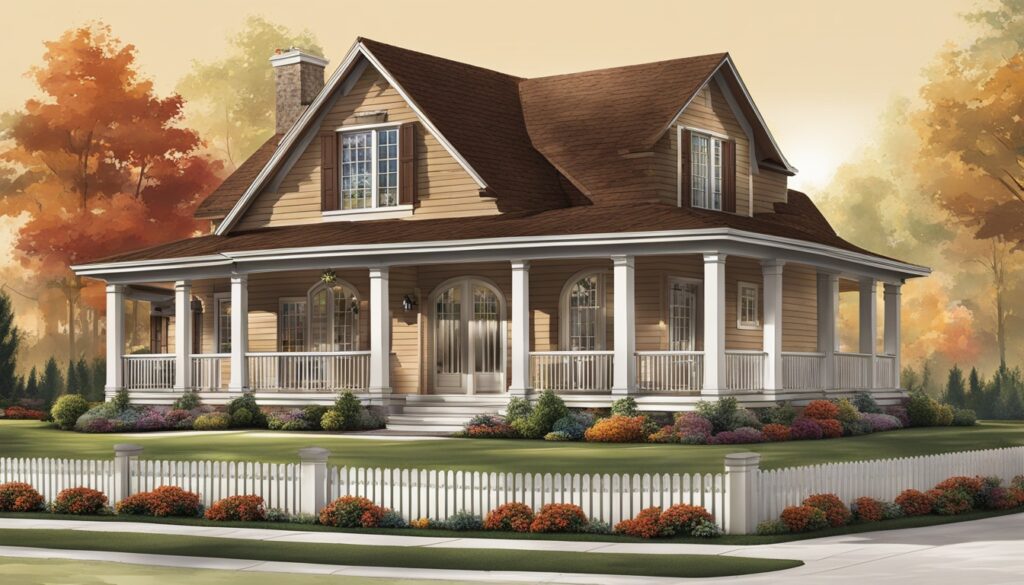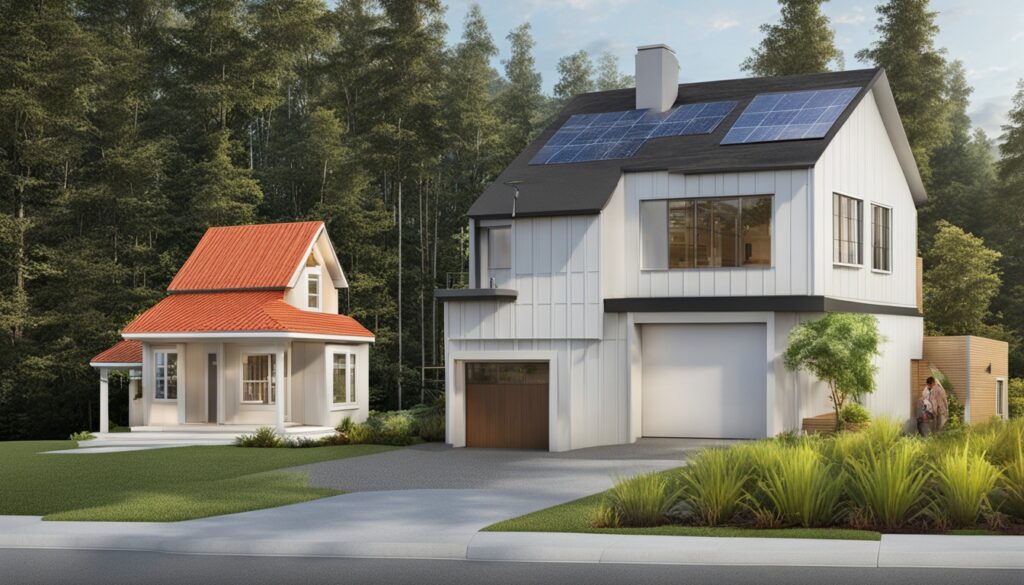Buying a home is a big financial step, and picking the right mortgage type is key. You'll have to decide between fixed-rate mortgages and adjustable-rate mortgages (ARMs). Each has its own pros and cons. We'll look at the main things to think about when choosing between them for your home loan.
Understanding Fixed-Rate and Adjustable-Rate Mortgages
Choosing a mortgage means deciding between fixed-rate and adjustable-rate mortgages. These options have different features that affect your monthly payments and long-term finances.
What is a Fixed-Rate Mortgage?
A fixed-rate mortgage has the same interest rate for the loan's life, usually 15 or 30 years. Your monthly payments stay the same, making budgeting easier. This type of mortgage offers stability and predictability, as the interest rate doesn't change with the market.
What is an Adjustable-Rate Mortgage (ARM)?
An adjustable-rate mortgage (ARM) has an interest rate that can change over time, based on market conditions. Your monthly payments could increase or decrease. ARMs often start with lower rates than fixed-rate mortgages but can change later.
https://www.youtube.com/watch?v=T_W4I5so6UA
It's important to know the differences between fixed-rate and adjustable-rate mortgages. This helps you pick the right one for your finances and goals. By considering the pros and cons, you can make a choice that suits you best.
Pros and Cons of Fixed-Rate Mortgages
A fixed-rate mortgage offers homebuyers many benefits. The main advantage is its predictability. With a fixed rate, your monthly mortgage interest rates stay the same for the loan's life. This means payment stability for you. It's great for those who like knowing their housing costs ahead of time.
Another plus of a fixed-rate mortgage is saving money over the long run. If mortgage interest rates go up, you won't see higher payments. But, this security comes with a cost. Fixed-rate mortgages usually have higher interest rates than adjustable-rate options, at least in the beginning.
| Advantages of Fixed-Rate Mortgages | Disadvantages of Fixed-Rate Mortgages |
|---|---|
| Predictable monthly payments | Slightly higher interest rates compared to ARMs |
| Protection against rising mortgage interest rates | Potentially higher long-term costs than adjustable-rate mortgages |
| Payment stability and budgeting certainty | Less flexibility than adjustable-rate mortgages |
A fixed-rate mortgage is a smart choice for those who want predictability and savings over time. It might have a higher initial interest rate, but it's worth it for the stability it offers.
"A fixed-rate mortgage provides the security of knowing your monthly payments will never change, making it easier to budget and plan for the long-term."

Advantages and Disadvantages of Adjustable-Rate Mortgages
Adjustable-rate mortgages (ARMs) have both good and bad points for homebuyers. They can offer lower initial interest rates and save money in the short term. But, they also have the risk of changing payments and uncertain interest rates.
Potential Risks of ARMs
The main risk of an ARM is that your monthly payments can change. If interest rates go up, your payments will too. This can make budgeting hard and planning for the future tough.
This is a big worry for homeowners on a fixed income or those who like knowing their mortgage payment won't change. They prefer the stability of a steady mortgage payment.
Benefits of ARMs
ARMs have a big advantage: lower initial interest rates. This means you can save money on your monthly payments. This is great for buyers who plan to sell their home soon or expect their income to rise.
ARMs also offer flexibility. If interest rates fall, you might be able to refinance to a lower rate. This could save you thousands over the loan's life.
How to Choose Between Fixed and Adjustable-Rate Mortgages
Choosing between a fixed-rate and an adjustable-rate mortgage is a big decision. It affects your financial future. Both types have their pros and cons. You need to think about what you need and want.
When picking, think about your money situation, your plans for the future, and current interest rates. Knowing the differences between fixed and adjustable-rate mortgages helps you make a choice that fits your needs.
A fixed-rate mortgage means your monthly payments stay the same. This protects you from market changes. An adjustable-rate mortgage might start with a lower rate but can change over time. This means your payments could go up or down with the market.

Choosing between fixed and adjustable-rate mortgages is a personal decision. You should look at the good and bad of each option. Think about your comfort with risk, your budget, and how long you plan to stay in the home. This way, you can pick the mortgage that works best for you and makes buying a home easier.
Factors to Consider When Choosing a Mortgage Type
Choosing the right mortgage type is a big decision that affects your finances for a long time. You need to think about your financial situation and your long-term vs. short-term plans for the property. These things help decide if a fixed-rate or adjustable-rate mortgage is best for you.
Your Financial Situation
Your financial situation is key when picking between a fixed-rate and adjustable-rate mortgage. Your income, job stability, and credit score affect how much you can borrow and the loan terms you get. It's important to know your finances well and how you can handle changes in mortgage payments over time.
Long-Term vs. Short-Term Plans
Think about how long you plan to live in the property. If you're staying long term, a fixed-rate mortgage might be best for stability and predictability. But if you're moving soon or expect big life changes, an adjustable-rate mortgage could be more flexible.
By looking at your financial situation and long-term vs. short-term plans, you can choose the right mortgage type for you. Remember, what works for someone else might not work for you. It's important to consider all the factors to find the mortgage that helps you financially in the long run.
Calculating the Costs: Fixed vs. Adjustable Rates
Choosing between a fixed-rate and an adjustable-rate mortgage (ARM) is a big decision. It affects your monthly payments and long-term costs. Let's explore how these mortgages can impact your finances.
Comparing Monthly Payments
Fixed-rate mortgages have the same monthly payment for the loan's life. This makes budgeting easier. ARMs, on the other hand, have rates that can change, affecting your monthly payment.
For example, a $300,000 mortgage with a 4.5% fixed rate would cost about $1,520 a month. An initial 3.5% ARM rate would make the payment around $1,347. But if the ARM rate went to 5.5%, your payment could jump to $1,703, possibly making it hard on your budget.
| Mortgage Type | Loan Amount | Interest Rate | Monthly Payment |
|---|---|---|---|
| Fixed-Rate | $300,000 | 4.5% | $1,520 |
| Adjustable-Rate (Initial) | $300,000 | 3.5% | $1,347 |
| Adjustable-Rate (After Adjustment) | $300,000 | 5.5% | $1,703 |
This example shows how interest rate changes can affect your monthly payments. It's important to think about the long-term costs when choosing between fixed-rate and adjustable-rate mortgages.
The Role of Interest Rate Trends in Your Decision
Choosing between a fixed-rate or adjustable-rate mortgage? It's key to know the current and future interest rate trends. The economy and Federal Reserve policies greatly affect mortgage rates, which in turn affects your choice.
Interest rate trends are key when picking your mortgage type. Fixed-rate mortgages are stable but their rates change with the economy and bond yields. Adjustable-rate mortgages (ARMs) have rates that change with the market and central bank policies.
Looking at mortgage rate forecasts helps predict future interest rates. Things like inflation, economic growth, and the Federal Reserve's policies affect mortgage rates. Knowing these trends helps you decide if a fixed-rate or adjustable-rate mortgage is best for you.
| Mortgage Type | Interest Rate Trend | Economic Factors |
|---|---|---|
| Fixed-Rate Mortgage | Influenced by long-term bond yields | Economic conditions, inflation |
| Adjustable-Rate Mortgage (ARM) | Fluctuates based on market conditions and central bank policies | Monetary policy decisions, economic growth |
Understanding interest rate trends helps you see the pros and cons of each mortgage type. This way, you can pick the one that fits your financial goals and future plans.
"Staying informed about interest rate trends and mortgage rate forecasts is crucial when choosing between a fixed-rate or adjustable-rate mortgage."
Seeking Professional Advice
Choosing between a fixed-rate or adjustable-rate mortgage can be tough. Getting advice from a professional mortgage lender or financial advisor is key. They have the mortgage expertise to guide you. They can help you pick the best option for your financial situation and goals.
Working with a Mortgage Lender
A good mortgage lender offers personalized advice. They look at your finances, future plans, and how much risk you can handle. This helps them suggest the best mortgage type for you.
They know a lot about the market and financing options. They'll help you make a smart choice. With their help, you can pick the right mortgage to meet your financial goals.
Working with a mortgage expert means you're making a confident choice. They offer insights and simplify the mortgage process. This can be a big help in reaching your financial goals.
FAQ
What is the difference between a fixed-rate mortgage and an adjustable-rate mortgage (ARM)?
A fixed-rate mortgage has a constant interest rate for the whole loan term. An adjustable-rate mortgage (ARM) has an interest rate that changes over time with the market.
What are the pros and cons of a fixed-rate mortgage?
Fixed-rate mortgages offer stable payments and easier budgeting. But, they usually start with higher interest rates than ARMs, leading to higher costs over time.
What are the potential risks of an adjustable-rate mortgage (ARM)?
ARMs can have changing payments because of rising interest rates. This can make budgeting hard and increase costs over time.
What factors should I consider when choosing between a fixed-rate and adjustable-rate mortgage?
Think about your finances, your plans for the property, interest rates now and in the future, and how you handle payment changes.
How can I calculate and compare the potential costs of a fixed-rate versus an adjustable-rate mortgage?
To compare costs, figure out your monthly payments for both types. Consider the interest rate, loan term, and ARM's rate changes. This shows the long-term effects of your choice.
Why is it important to seek professional advice when choosing a mortgage type?
Talking to a mortgage lender or financial advisor is crucial. They can offer insights and advice based on your financial situation and market trends. This helps you pick the best mortgage for you.









0 Comments